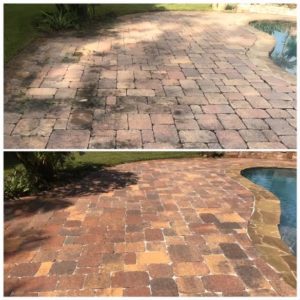Tru-Alpha Paver Seal is a multi-surface sealer for pavers, natural stone, brick, and concrete. It is a concentrated water-based Aliphatic Urethane that penetrates and seals. It allows for cleaning and sealing to all be done in a single day, unlike solvent-based sealers. This is the best paver sealer that inhibits weed, algae, and mold growth as well as stabilizes the sand in the joints between the pavers. No expensive polymeric sand is necessary. To apply this sealer for your pavers, you will mix part A and part B then dilute 1:1 with water. This dilution allows the product to be sprayed through a pump-up sprayer and will penetrate into the paver. Pour the diluted product into a multi-purpose pump-up sprayer and back roll with a ⅜” roller nap to help the product achieve a consistent finish. Two coats is recommended as the first coat penetrates, while the second builds solids on the surface. After the first coat, you will see some enhanced color and that may be all you need. However, two coats are recommended for porous stones, bricks, or pavers and will increase color enhancement, chemical and stain resistance, and longevity. Once the first coat is dry, you may apply the second coat of sealer.
This sealer comes in 1.25-gallon concentrates(yields 2.5 gallons of product, 1,000 sqft depending on porosity) and 5-gallon concentrates(yields 10 gallons of product, 4,000 sqft). Available in Satin and Natural sheens.
What Should You Look For When Choosing A Sealer For Your Pavers
The Wrong Sealer
Have you ever passed a home with a paver driveway and noticed some of the pavers have a white haze or cloud on their surface? Many of the sealers sold by large box stores are not “breathable”. They are formulated to keep water and moisture from moving down into the paver from the top side but do not allow moisture to migrate from inside the paver outwards. In turn, this causes moisture to build up just beneath the  sealer leading to a white haze or cloudy appearance, and possibly delamination (sealer failure). Fixing this issue can be costly so why not use a sealer that has been designed to protect your pavers AND not create additional issues due to our moist climate.
sealer leading to a white haze or cloudy appearance, and possibly delamination (sealer failure). Fixing this issue can be costly so why not use a sealer that has been designed to protect your pavers AND not create additional issues due to our moist climate.
White Haze Correction
The best way to correct moisture trapped under the sealer of your pavers is to chemically strip the sealer that is trapping the moisture. It is important to choose a stripper that will not damage the paver. The option we recommend is Fast Strip. This stripper is non-flammable, sprayable, and is free from Methylene Chloride. Fast Strip will emulsify most paver sealers, including acrylics, water-based epoxies, and enamels. Repeat the application until everything is removed. Follow up with pressure washing, resanding if needed, and then choose the perfect sealer for your pavers. Select Surface Solutions reccomends you apply Tru-Alpha Paver Seal.
Thank you for reading this article by Select Surface Solutions. We are a family-owned and operated supplier that specializes in decorative concrete, coatings, tooling, and technical support. We are located in Orlando, Florida and we carry well-known brands like Ameripolish, Surecrete, TK Products, Coatings Solutions, Trinic, Midwest Rake, Marshalltown, Wooster, and many more. Check us out on Facebook and Instagram @selectsurfacesolutions !
Select Surface Solutions
207 N Goldenrod Road, Suite 100
Orlando, FL 32807
407-730-3103
info@selectsurfacesoln.com
